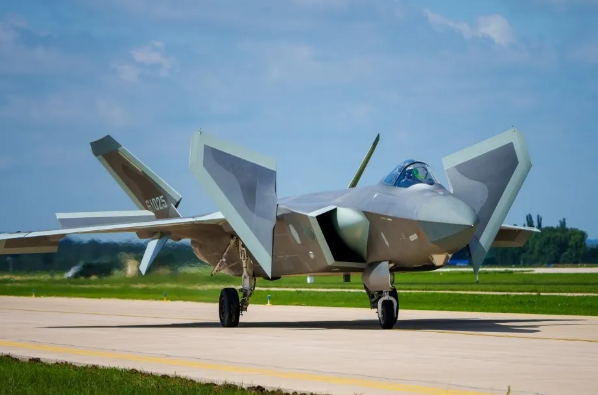

转载《战区TheWarZone》官网头条文章--中国**飞行器的突然出现(英译中全文)
编辑:2024-12-30 16:39:47
This is the most advanced flying machine we have seen out of China, lacking any tails and packing stealth and long range.
Thomas Newdick and Tyler Rogoway
作者:托马斯·纽迪克和泰勒·罗戈威
There has also been no official comment from the Chinese Ministry of Defense or state media so far.
Aside from the sheer size of the new aircraft, which we will address in a moment, the most striking thing about it is its planform and tailless configuration. It has a modified delta wing with chine lines extending all the way to the nose area, while its central fuselage section, at least the bottom of it, is loosely reminiscent of the J-20. The broad nose could even provide space for side-by-side crew seating, although the limited views of the canopy mean we cannot be sure whether the aircraft has a single-seat or two-seat arrangement, with tandem twin seats being another option.
到目前为止,中国国防部或官方媒体也没有发表官方评论。
除了我们稍后将讨论的新飞机的庞大尺寸之外,它*引人注目的是它的平面形状和无尾配置。它有一个改进的三角翼,下巴线条一直延伸到机头区域,而它的中央机身部分,至少是它的底部,松散地让人想起 J-20。宽大的机头甚至可以为并排的机组人员提供空间,尽管座舱盖的视野有限意味着我们无法确定飞机是单座还是双座安排,串联双座是另一种选择。
There was already growing evidence pointing to the fact that China’s next fighter would be tailless, and designs of this kind had previously appeared in the form of technical studies. Back in October 2021, a mysterious tailless aircraft shape appeared in satellite images of a CAC factory airfield. It was a large modified-diamond-like delta planform with a relatively thin nose section that also had a significant wingspan — broadly similar to that of a J-20. But it’s worth noting that this shape does not look the same as the aircraft we are seeing.
Beyond that, next-generation tactical combat aircraft eschewing traditional tails is a major design driver being pursued the U.S. military, as well. This is predominantly to significantly reduce the aircraft’s radar signature across multiple bands and from all aspects. There are some aerodynamic efficiencies also to be had with such a design, especially one used for long-range operations via a reduction in aerodynamic drag, which should provide better performance for sustained high-speed dashes and cruising flight. At the same time, a tailless configuration can adversely affect overall maneuverability, even with the most advanced computerized flight control systems. There are currently no signs of thrust-vectoring engines on this aircraft, which would help enhance agility and overall stability. The engine exhausts are mounted in the best place to mask the aircraft’s infrared signature, atop the rear of its fuselage, similar to the YF-23.
已经有越来越多的证据表明,中国的下一款战斗机将是无尾战斗机,而这种设计以前曾以技术研究的形式出现。早在 2021 年 10 月,CAC 工厂机场的卫星图像中就出现了一个神秘的无尾飞机形状。它是一个大型的改良菱形三角形平面形状,机头截面相对较薄,翼展也很大——与歼-20 的翼展大致相似。但值得注意的是,这种形状看起来与我们看到的飞机不同。
除此之外,避开传统尾翼的下一代战术战斗机也是美国军方追求的主要设计驱动力。这主要是为了从多个频段和各个方面显著降低飞机的雷达特征。这种设计也有一些空气动力学效率,特别是通过减少空气动力学阻力用于远程操作的设计,这应该为持续的高速冲刺和巡航飞行提供更好的性能。同时,无尾配置会对整体机动性产生不利影响,即使使用**的计算机化飞行控制系统也是如此。目前这架飞机上没有推力矢量发动机的迹象,这将有助于提高敏捷性和整体稳定性。发动机排气口安装在机身后部顶部的*佳位置,以掩盖飞机的红外特征,类似于 YF-23。
While a tailless configuration, size, general shaping, and exhaust layout point directly toward a design tailored for stealth and endurance, it’s not entirely clear the exact level of enhanced low observability this new aircraft might offer. Just deleting the tail surfaces and strakes and providing a more general aerodynamic clean-up, while leveraging the same now nearly 15-year-old technology found on the the J-20, for example, would still be a massive improvement. Clearly, this aircraft incorporates significantly greater low observable technologies that are a leap ahead of the J-20, beyond its tailless design.
Also notable is the elaborate arrangement of control surfaces coupled with the tailless design, with five trailing edge control surfaces per wing. These include prominent split flaps close to the wingtips. These would be used differentially to provide yaw control in the absence of tail control surfaces, as well as deploying simultaneously to serve as air brakes.
虽然无尾配置、尺寸、总体形状和排气布局直接指向为隐身和耐力量身定制的设计,但目前尚不完全清楚这款新飞机可能提供的增强低可观察性的确切水平。例如,仅仅删除尾部表面和条纹并提供更通用的空气动力学清理,同时利用 J-20 上现在近 15 年的历史的技术,仍然将是一个巨大的改进。显然,这架飞机采用了明显更大的低可观察技术,这些技术超越了歼-20,超越了其无尾设计。
同样值得注意的是控制面的精心布置,加上无尾设计,每个机翼有五个后缘控制面。这些包括靠近翼尖的突出的裂开襟翼。这些将用于在没有尾部控制面的情况下提供偏航控制,以及同时部署以用作空气制动器。
In terms of size, the new aircraft can be compared to the J-20 — the imagery suggests it is at least as long. The J-20 is close to 70 feet from nose to tail. In this regard, this design’s twin-wheel main landing gear is also worth noting, providing another pointer to the considerable weight of the aircraft. Above all, its large size would seem to reflect an overarching concern with long endurance with comparatively massive internal volume to accommodate a very large fuel load, as well as weapons and sensors.
就尺寸而言,这架新飞机可以与 J-20 相提并论——图像表明它至少一样长。歼-20 从机头到机尾接近 70 英尺。在这方面,这种设计的双轮主起落架也值得注意,这为飞机的相当重量提供了另一个指标。*重要的是,它的大尺寸似乎反映了对长续航性的首要关注,其内部容积相对较大,可以容纳非常大的燃料负载,以及武器和传感器。
Maybe the aircraft’s most unusual feature is its air intake arrangement. It appears to have an air intake on top of the fuselage, as well as twin intakes on either side of the lower fuselage. This has already led to speculation that the aircraft may have a highly unorthodox three-engine arrangement. Unconfirmed rumors point to a powerplant comprising three domestically produced WS-10C turbofans, as used in the J-20. Considering the aircraft’s higher gross weight than the J-20, three engines may be necessary in order to meet aggressive performance goals, especially for sustained high-speed flight and operations at high altitudes.
That China has been working on a sixth-generation combat aircraft program is also no surprise.
Back in September 2022, now-retired Air Force Gen. Mark D. Kelly, who was then the head of Air Combat Command (ACC), said that China was working on the same kind of air combat ‘system of systems’ that his service was pursuing under its Next Generation Air Dominance (NGAD) initiative, including a sixth-generation manned fighter jet.
At the time, Kelly noted that China saw sixth-generation air power, including future manned fighter aircraft, “greatly the way we see it: an exponential reduction in signature, exponential acceleration of processing power and sensing.” Another key factor would be the ability to “iterate” improvements aided by open mission systems, Kelly added.
也许这架飞机*不寻常的特点是它的进气装置。它似乎在机身顶部有一个进气口,在机身下部的两侧还有一个双进气口。这已经导致人们猜测这架飞机可能具有非常非正统的三引擎布置。未经证实的谣言指出,该动力装置由三台国产 WS-10C 涡扇发动机组成,用于 J-20。考虑到飞机的总重量高于 J-20,可能需要三个发动机才能满足激进的性能目标,特别是对于持续的高速飞行和高空操作。
中国一直在致力于第六代战斗机计划也就不足为奇了。
早在 2022 年 9 月,时任空战司令部 (ACC) 负责人、现已退役的空军上将马克·凯利 (Mark D. Kelly) 表示,中国正在研究与他的军种在下一代空中优势 (NGAD) 计划下追求的相同类型的空战“系统”,包括第六代有人驾驶战斗机。
当时,凯利指出,中国看到了第六代空中力量,包括未来的有人驾驶战斗机,“与我们的看法非常相似:雷达特征呈指数级减少,处理能力和传感能力呈指数级加速。Kelly 补充说,另一个关键因素是在开放式任务系统的帮助下“迭代”改进的能力。
Regarding a potential successor to the J-20, Gen. Kelly warned that China “are not dummies. They know what they’re doing.”
Kelly also said he expected the Chinese sixth-generation air combat program to include an “exponential” improvement in stealth compared with current platforms.
At this early stage, it’s far from clear whether the new aircraft is a prototype sixth-generation fighter, or perhaps a more generalized demonstrator that will test new technologies that could potentially end up on a variety of different platforms, including a large tactical aircraft much like it. It seems almost certain that China, for some time now, has been engaged in preliminary testing of different manned fighter configurations. This development work may also include demonstrators, both sub-scale and full-size, and the new aircraft may well be related to it.
关于歼-20的潜在继任者,凯利将*告说,中国“不是傻瓜。他们知道自己在做什么。
凯利还表示,他预计中国的第六代空战计划将包括与当前平台相比,隐身能力的“指数级”改进。
在这个早期阶段,目前还不清楚这架新飞机是第六代战斗机原型,还是更通用的演示机,它将测试可能*终出现在各种不同平台上的新技术,包括与它非常相似的大型战术飞机。几乎可以肯定的是,中国已经对不同的有人驾驶战斗机配置进行了一段时间的初步测试。这项开发工作还可能包括小规模和全尺寸的演示机,新飞机很可能与之相关。
The aircraft could also be related to a new regional stealth bomber aircraft, which could potentially be a crewed component tied to the broader Chinese sixth-generation airpower initiative.
The regional bomber program, known as JH-XX, remains very secretive, but you can read more about what is known about that project here. Previously, it was thought that the Shenyang Aircraft Corporation might be working on the JH-XX, in which case a J-20 chase plane, from the rival Chengdu, would seem less likely.
More likely, at least at this time, this aircraft could be more closely tied to China’s version of America’s Next Generation Air Dominance initiative, which aimed to develop a similar manned heavy ‘fighter’-like aircraft that would work just as much as a command and control node for drones as a classic fighter. Range, sustained speed in cruise, weapons payload, and low observability are all thought to be top priorities of the manned fighter component of NGAD, or at least were. The fighter element of the program is now on hold and still may be canceled entirely, or end up looking very different, under the Trump administration.
The fact that this exotic aircraft was flying during the day, in an area where it was seemingly easily photographed also tells a lot about the program’s status. It is very likely China intended for this to be seen at this time.
Overall, while so much remains unknown, what we can say about this aircraft definitively is that it’s a large, very heavy, tactical jet that has had a massive premium put on combat radios and survivability. High altitude operations are also likely a feature of this design, especially if it does indeed feature three engines. But above all else, if procured in an operation form by the PLAAF, it would be able to fly over long regional distances and loiter for extended periods on station far from home without tanker support — something China lacks in terms of capacity versus the United States. It would also presumably be able to do this in closer proximity to threats than any other manned aircraft in China’s arsenal.
In other words, it could put targets in the air, on the ground, and at sea at risk in areas where they currently do not expect a threat from a manned combat aircraft. This has real implications for American tankers, airlifters, and airborne early warning and control, and reconnaissance aircraft, as well as allied ships and forces operating at forward locales. It would also serve as a critical force-multiplying sensor platform operating far forward. Paired with drone wingmen of relevant endurance, its lethality and survivability would be multiplied.
In other words, the existence of this aircraft is a very big deal.
这架飞机还可能与一种新的支线隐形轰炸机有关,该飞机可能是与更广泛的中国第六代空中力量计划相关的载人部件。
被称为 JH-XX 的区域轰炸机计划仍然非常保密,但您可以在此处阅读有关该项目的更多信息。此前,人们认为沈阳飞机有限责任公司可能正在开发 JH-XX,在这种情况下,来自竞争对手成都的 J-20 追逐机似乎不太可能。
更有可能的是,至少在此时,这架飞机可能与中国版的美国下一代空中优势计划更紧密地联系在一起,该计划旨在开发一种类似的载人重型“战斗机”式飞机,该飞机将像经典战斗机一样作为无人机的指挥和控制节点。航程、巡航持续速度、武器有效载荷和低可观测性都被认为是 NBAD 有人驾驶战斗机组件的首要任务,或者至少是这样。该计划的战斗机元素现在被搁置,在特朗普政府的领导下,它仍然可能被完全取消,或者*终看起来非常不同。
这架异国情调的飞机在白天飞行,在一个似乎很容易被拍摄的区域,这一事实也充分说明了该计划的状态。中国很可能打算在这个时候看到这一点。
总的来说,虽然还有很多未知数,但我们可以肯定地说这架飞机是一架大型、非常重的战术喷气式飞机,在战斗无线电和生存能力方面具有巨大的优势。高空操作也可能是这种设计的一个特点,特别是如果它确实具有三个发动机。但*重要的是,如果中国人民解放军空军以作战形式采购,它将能够在没有加油机支持的情况下,在远离家乡的站点进行长距离飞行和长时间徘徊——这是中国在能力方面与美国相比所缺乏的。据推测,它也可能能够比中国军火库中的任何其他有人驾驶飞机更接近威胁地做到这一点。
换句话说,它可以使空中、地面和海上的目标处于危险之中,而这些区域目前预计有人驾驶战斗机不会对这些目标构成威胁。这对美国加油机、空运机、空中预警和控制机、侦察机以及在前沿地区行动的盟军舰艇和部队具有真正的影响。它还将作为一个关键的力倍增传感器平台,在远方工作。与具有相关续航能力的无人机僚机配对,它的杀伤力和生存能力将成倍增加。
换句话说,这架飞机的存在是一件非常重要的事情。

转载《战区TheWarZone》官网头条文章--中国**飞行器的突然出现(英译中全文)
编辑:2024-12-30 16:39:47
This is the most advanced flying machine we have seen out of China, lacking any tails and packing stealth and long range.
Thomas Newdick and Tyler Rogoway
作者:托马斯·纽迪克和泰勒·罗戈威
There has also been no official comment from the Chinese Ministry of Defense or state media so far.
Aside from the sheer size of the new aircraft, which we will address in a moment, the most striking thing about it is its planform and tailless configuration. It has a modified delta wing with chine lines extending all the way to the nose area, while its central fuselage section, at least the bottom of it, is loosely reminiscent of the J-20. The broad nose could even provide space for side-by-side crew seating, although the limited views of the canopy mean we cannot be sure whether the aircraft has a single-seat or two-seat arrangement, with tandem twin seats being another option.
到目前为止,中国国防部或官方媒体也没有发表官方评论。
除了我们稍后将讨论的新飞机的庞大尺寸之外,它*引人注目的是它的平面形状和无尾配置。它有一个改进的三角翼,下巴线条一直延伸到机头区域,而它的中央机身部分,至少是它的底部,松散地让人想起 J-20。宽大的机头甚至可以为并排的机组人员提供空间,尽管座舱盖的视野有限意味着我们无法确定飞机是单座还是双座安排,串联双座是另一种选择。
There was already growing evidence pointing to the fact that China’s next fighter would be tailless, and designs of this kind had previously appeared in the form of technical studies. Back in October 2021, a mysterious tailless aircraft shape appeared in satellite images of a CAC factory airfield. It was a large modified-diamond-like delta planform with a relatively thin nose section that also had a significant wingspan — broadly similar to that of a J-20. But it’s worth noting that this shape does not look the same as the aircraft we are seeing.
Beyond that, next-generation tactical combat aircraft eschewing traditional tails is a major design driver being pursued the U.S. military, as well. This is predominantly to significantly reduce the aircraft’s radar signature across multiple bands and from all aspects. There are some aerodynamic efficiencies also to be had with such a design, especially one used for long-range operations via a reduction in aerodynamic drag, which should provide better performance for sustained high-speed dashes and cruising flight. At the same time, a tailless configuration can adversely affect overall maneuverability, even with the most advanced computerized flight control systems. There are currently no signs of thrust-vectoring engines on this aircraft, which would help enhance agility and overall stability. The engine exhausts are mounted in the best place to mask the aircraft’s infrared signature, atop the rear of its fuselage, similar to the YF-23.
已经有越来越多的证据表明,中国的下一款战斗机将是无尾战斗机,而这种设计以前曾以技术研究的形式出现。早在 2021 年 10 月,CAC 工厂机场的卫星图像中就出现了一个神秘的无尾飞机形状。它是一个大型的改良菱形三角形平面形状,机头截面相对较薄,翼展也很大——与歼-20 的翼展大致相似。但值得注意的是,这种形状看起来与我们看到的飞机不同。
除此之外,避开传统尾翼的下一代战术战斗机也是美国军方追求的主要设计驱动力。这主要是为了从多个频段和各个方面显著降低飞机的雷达特征。这种设计也有一些空气动力学效率,特别是通过减少空气动力学阻力用于远程操作的设计,这应该为持续的高速冲刺和巡航飞行提供更好的性能。同时,无尾配置会对整体机动性产生不利影响,即使使用**的计算机化飞行控制系统也是如此。目前这架飞机上没有推力矢量发动机的迹象,这将有助于提高敏捷性和整体稳定性。发动机排气口安装在机身后部顶部的*佳位置,以掩盖飞机的红外特征,类似于 YF-23。
While a tailless configuration, size, general shaping, and exhaust layout point directly toward a design tailored for stealth and endurance, it’s not entirely clear the exact level of enhanced low observability this new aircraft might offer. Just deleting the tail surfaces and strakes and providing a more general aerodynamic clean-up, while leveraging the same now nearly 15-year-old technology found on the the J-20, for example, would still be a massive improvement. Clearly, this aircraft incorporates significantly greater low observable technologies that are a leap ahead of the J-20, beyond its tailless design.
Also notable is the elaborate arrangement of control surfaces coupled with the tailless design, with five trailing edge control surfaces per wing. These include prominent split flaps close to the wingtips. These would be used differentially to provide yaw control in the absence of tail control surfaces, as well as deploying simultaneously to serve as air brakes.
虽然无尾配置、尺寸、总体形状和排气布局直接指向为隐身和耐力量身定制的设计,但目前尚不完全清楚这款新飞机可能提供的增强低可观察性的确切水平。例如,仅仅删除尾部表面和条纹并提供更通用的空气动力学清理,同时利用 J-20 上现在近 15 年的历史的技术,仍然将是一个巨大的改进。显然,这架飞机采用了明显更大的低可观察技术,这些技术超越了歼-20,超越了其无尾设计。
同样值得注意的是控制面的精心布置,加上无尾设计,每个机翼有五个后缘控制面。这些包括靠近翼尖的突出的裂开襟翼。这些将用于在没有尾部控制面的情况下提供偏航控制,以及同时部署以用作空气制动器。
In terms of size, the new aircraft can be compared to the J-20 — the imagery suggests it is at least as long. The J-20 is close to 70 feet from nose to tail. In this regard, this design’s twin-wheel main landing gear is also worth noting, providing another pointer to the considerable weight of the aircraft. Above all, its large size would seem to reflect an overarching concern with long endurance with comparatively massive internal volume to accommodate a very large fuel load, as well as weapons and sensors.
就尺寸而言,这架新飞机可以与 J-20 相提并论——图像表明它至少一样长。歼-20 从机头到机尾接近 70 英尺。在这方面,这种设计的双轮主起落架也值得注意,这为飞机的相当重量提供了另一个指标。*重要的是,它的大尺寸似乎反映了对长续航性的首要关注,其内部容积相对较大,可以容纳非常大的燃料负载,以及武器和传感器。
Maybe the aircraft’s most unusual feature is its air intake arrangement. It appears to have an air intake on top of the fuselage, as well as twin intakes on either side of the lower fuselage. This has already led to speculation that the aircraft may have a highly unorthodox three-engine arrangement. Unconfirmed rumors point to a powerplant comprising three domestically produced WS-10C turbofans, as used in the J-20. Considering the aircraft’s higher gross weight than the J-20, three engines may be necessary in order to meet aggressive performance goals, especially for sustained high-speed flight and operations at high altitudes.
That China has been working on a sixth-generation combat aircraft program is also no surprise.
Back in September 2022, now-retired Air Force Gen. Mark D. Kelly, who was then the head of Air Combat Command (ACC), said that China was working on the same kind of air combat ‘system of systems’ that his service was pursuing under its Next Generation Air Dominance (NGAD) initiative, including a sixth-generation manned fighter jet.
At the time, Kelly noted that China saw sixth-generation air power, including future manned fighter aircraft, “greatly the way we see it: an exponential reduction in signature, exponential acceleration of processing power and sensing.” Another key factor would be the ability to “iterate” improvements aided by open mission systems, Kelly added.
也许这架飞机*不寻常的特点是它的进气装置。它似乎在机身顶部有一个进气口,在机身下部的两侧还有一个双进气口。这已经导致人们猜测这架飞机可能具有非常非正统的三引擎布置。未经证实的谣言指出,该动力装置由三台国产 WS-10C 涡扇发动机组成,用于 J-20。考虑到飞机的总重量高于 J-20,可能需要三个发动机才能满足激进的性能目标,特别是对于持续的高速飞行和高空操作。
中国一直在致力于第六代战斗机计划也就不足为奇了。
早在 2022 年 9 月,时任空战司令部 (ACC) 负责人、现已退役的空军上将马克·凯利 (Mark D. Kelly) 表示,中国正在研究与他的军种在下一代空中优势 (NGAD) 计划下追求的相同类型的空战“系统”,包括第六代有人驾驶战斗机。
当时,凯利指出,中国看到了第六代空中力量,包括未来的有人驾驶战斗机,“与我们的看法非常相似:雷达特征呈指数级减少,处理能力和传感能力呈指数级加速。Kelly 补充说,另一个关键因素是在开放式任务系统的帮助下“迭代”改进的能力。
Regarding a potential successor to the J-20, Gen. Kelly warned that China “are not dummies. They know what they’re doing.”
Kelly also said he expected the Chinese sixth-generation air combat program to include an “exponential” improvement in stealth compared with current platforms.
At this early stage, it’s far from clear whether the new aircraft is a prototype sixth-generation fighter, or perhaps a more generalized demonstrator that will test new technologies that could potentially end up on a variety of different platforms, including a large tactical aircraft much like it. It seems almost certain that China, for some time now, has been engaged in preliminary testing of different manned fighter configurations. This development work may also include demonstrators, both sub-scale and full-size, and the new aircraft may well be related to it.
关于歼-20的潜在继任者,凯利将*告说,中国“不是傻瓜。他们知道自己在做什么。
凯利还表示,他预计中国的第六代空战计划将包括与当前平台相比,隐身能力的“指数级”改进。
在这个早期阶段,目前还不清楚这架新飞机是第六代战斗机原型,还是更通用的演示机,它将测试可能*终出现在各种不同平台上的新技术,包括与它非常相似的大型战术飞机。几乎可以肯定的是,中国已经对不同的有人驾驶战斗机配置进行了一段时间的初步测试。这项开发工作还可能包括小规模和全尺寸的演示机,新飞机很可能与之相关。
The aircraft could also be related to a new regional stealth bomber aircraft, which could potentially be a crewed component tied to the broader Chinese sixth-generation airpower initiative.
The regional bomber program, known as JH-XX, remains very secretive, but you can read more about what is known about that project here. Previously, it was thought that the Shenyang Aircraft Corporation might be working on the JH-XX, in which case a J-20 chase plane, from the rival Chengdu, would seem less likely.
More likely, at least at this time, this aircraft could be more closely tied to China’s version of America’s Next Generation Air Dominance initiative, which aimed to develop a similar manned heavy ‘fighter’-like aircraft that would work just as much as a command and control node for drones as a classic fighter. Range, sustained speed in cruise, weapons payload, and low observability are all thought to be top priorities of the manned fighter component of NGAD, or at least were. The fighter element of the program is now on hold and still may be canceled entirely, or end up looking very different, under the Trump administration.
The fact that this exotic aircraft was flying during the day, in an area where it was seemingly easily photographed also tells a lot about the program’s status. It is very likely China intended for this to be seen at this time.
Overall, while so much remains unknown, what we can say about this aircraft definitively is that it’s a large, very heavy, tactical jet that has had a massive premium put on combat radios and survivability. High altitude operations are also likely a feature of this design, especially if it does indeed feature three engines. But above all else, if procured in an operation form by the PLAAF, it would be able to fly over long regional distances and loiter for extended periods on station far from home without tanker support — something China lacks in terms of capacity versus the United States. It would also presumably be able to do this in closer proximity to threats than any other manned aircraft in China’s arsenal.
In other words, it could put targets in the air, on the ground, and at sea at risk in areas where they currently do not expect a threat from a manned combat aircraft. This has real implications for American tankers, airlifters, and airborne early warning and control, and reconnaissance aircraft, as well as allied ships and forces operating at forward locales. It would also serve as a critical force-multiplying sensor platform operating far forward. Paired with drone wingmen of relevant endurance, its lethality and survivability would be multiplied.
In other words, the existence of this aircraft is a very big deal.
这架飞机还可能与一种新的支线隐形轰炸机有关,该飞机可能是与更广泛的中国第六代空中力量计划相关的载人部件。
被称为 JH-XX 的区域轰炸机计划仍然非常保密,但您可以在此处阅读有关该项目的更多信息。此前,人们认为沈阳飞机有限责任公司可能正在开发 JH-XX,在这种情况下,来自竞争对手成都的 J-20 追逐机似乎不太可能。
更有可能的是,至少在此时,这架飞机可能与中国版的美国下一代空中优势计划更紧密地联系在一起,该计划旨在开发一种类似的载人重型“战斗机”式飞机,该飞机将像经典战斗机一样作为无人机的指挥和控制节点。航程、巡航持续速度、武器有效载荷和低可观测性都被认为是 NBAD 有人驾驶战斗机组件的首要任务,或者至少是这样。该计划的战斗机元素现在被搁置,在特朗普政府的领导下,它仍然可能被完全取消,或者*终看起来非常不同。
这架异国情调的飞机在白天飞行,在一个似乎很容易被拍摄的区域,这一事实也充分说明了该计划的状态。中国很可能打算在这个时候看到这一点。
总的来说,虽然还有很多未知数,但我们可以肯定地说这架飞机是一架大型、非常重的战术喷气式飞机,在战斗无线电和生存能力方面具有巨大的优势。高空操作也可能是这种设计的一个特点,特别是如果它确实具有三个发动机。但*重要的是,如果中国人民解放军空军以作战形式采购,它将能够在没有加油机支持的情况下,在远离家乡的站点进行长距离飞行和长时间徘徊——这是中国在能力方面与美国相比所缺乏的。据推测,它也可能能够比中国军火库中的任何其他有人驾驶飞机更接近威胁地做到这一点。
换句话说,它可以使空中、地面和海上的目标处于危险之中,而这些区域目前预计有人驾驶战斗机不会对这些目标构成威胁。这对美国加油机、空运机、空中预警和控制机、侦察机以及在前沿地区行动的盟军舰艇和部队具有真正的影响。它还将作为一个关键的力倍增传感器平台,在远方工作。与具有相关续航能力的无人机僚机配对,它的杀伤力和生存能力将成倍增加。
换句话说,这架飞机的存在是一件非常重要的事情。

备案号:京ICP备18046128号 京公网安备110102000301-1
广播电视节目许可证号 (京)字第16035号




